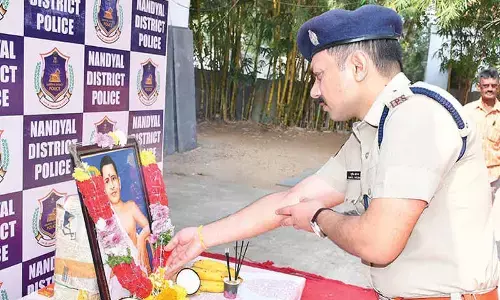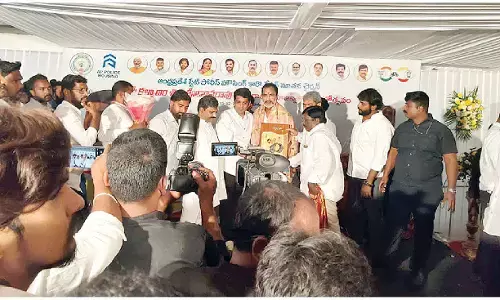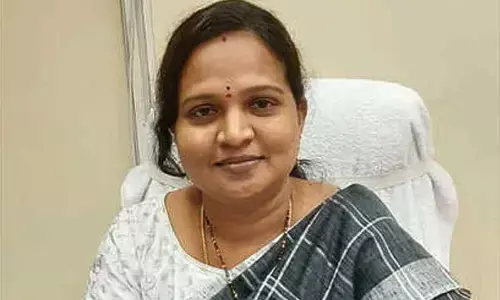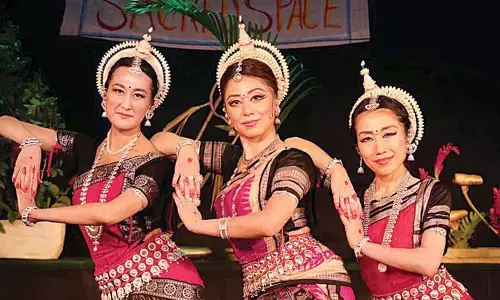A legend an inspiration: Vedantam Raghavaiah in the minds of all Telugu film lovers

Vedantam Raghavaiah’s name in enshrined in gold letters in the pages of Telugu film history.
Vedantam Raghavaiah -- the name triggers nostalgia of the Telugu films of fifties and sixties in the minds of all Telugu film lovers. His creative productions were a unique combination of both artistic excellence and commercial success. They emanated classicism whether they struck the chords of the emotions of the audiences by reflecting human values, bonds, sensitivity and relationships, or were movies which beleaguered them in myth, reverie, fancy or fantasy. But his roots as an artist, performer, and choreographer par excellence which lie in the art form of Kuchipudi are less known even to his admirers. These unique talents he possessed served as an essential backdrop for his success in the film industry – success, which is but the tip of an iceberg, when the multi dimensional personality of this genius is considered in totality.
Golden Era for Kuchipudi
Born on June 8, 1919 to Vedantam Ramayya and Annapurnamma, descendants of one of the legendary families of Kuchipudi in which art simply runs in the blood, Vedantam Raghavaiah, a flawless dancer, melodious singer and an expert in the tala system was highly admired. Genetically endowed with these talents, he polished them to perfection under some of the most distinguished masters of the time. At the tender age of five, Raghavaiah started his formal training under Chinta Venkataramayya and shone as one of his star students. With passion and devotion, Raghavaiah indulged himself completely in imbibing the technicalities of dance, music, tala and stage-presentation, simultaneously, absorbing all the nuances of laya under Vempati Venkatanarayana, a genius known as 'Laya Brahma.' Consequently, his debut performance at the tender age of seven, as Prahlada, was awarded with a gold medal by the British Government. This is considered by the artists of the time as the beginning of the 'Swarna-adhayanam,' or 'Golden Era for Kuchipudi' as this was the first accolade that was given to the art form by the then ruling government. He continued to enthrall in the roles of Lohitasya, Kusa, Lava and others and later became one of the outstanding 'bhrukumsas' (female impersonator) of his time by mastering the Kaisiki vritti. Being no ordinary singer, Raghavaiah would sing while performing, playing upon the 'mukhya sancharas' or the key-notes of every ragam of any daruvu and this made his performances scintillating. Raghavaiah made an 'Usha kanya' par excellence, and his matchless performances in the characters of Sita, Leelavathi, Chandramathi, Sasirekha, Mohini and Satyabhama are still remembered. Just when he was being branded as an excellent bhrukumsa, he took it up as a challenge and created waves by performing the key male roles like Harischandra, Hiranyakashyapa, Rama and Krishna.
Man of the Era
Raghavaiah was highly admired in the intellectual circles of art because of his powerful demonstrations of sloka abhinayas and pada abhinayas, elaborating upon their meanings and contrasting their presentations in dance and drama. He won the high appreciation of many scholars, like Adibhatla Narayanadas, the Harikatha Pitamaha, who gave Raghavaiah the title of 'Sakapurusha' or 'Man of the Era' and also awarded him with a gold medal.
Filmography
Talk of Raghavaiah's talents spread far and wide by the mid thirties and it was the time when the Telugu film industry was slowly evolving; and, requiring technicians from specialized fields to contribute their expertise, the directors felt the dearth especially of a professional dancer who could cater to their needs. One such director came across Raghavaiah and this began a totally novel era in the history of Kuchipudi, as the dance form was first placed on the celluloid through the movie 'Raithubidda' (1939), in which Raghavaiah performed the traditional 'Dasavatara Sabdam'. He also acted in a few movies like 'Garudagarvabhangam' (1943), 'Mayalokam' (1947), 'Raksharekha' (1949), 'Anarkali' (1955) and 'Rahasyam' (1967); and naturally, he was approached to choreograph dances for songs in films. Though there was no take off point for him as he was the pioneer of film dances, the transformation of the live performer on stage into a choreographer for films was very smooth because of his great acumen for dance and for art as a whole. Raghavaiah's journey, as an exclusive dance director, began with the two films 'Pantulamma' and 'Garudagarvabhangam' (1943). 'Sitaramajananam' (1944) followed and 'Swargaseema' (1945) has a traditional Veedhi Bhagavatam of 'Mohini Rukmangada', and a padam 'Manchidinamu nede', which was impressively done in the traditional Kuchipudi style. He received high acclaim for 'Thyagayya' (1946), whose crowning glory is 'Gopikakrishna', in which he elicited brilliant performances from children below ten years of age, to depict the famous episode in which Thyagayya dedicates the Anandabhairavi ragam to Kuchipudi artists. 'Yogi Vemana' (1947), 'Balaraju' (1948), 'Keelugurram' (1949), 'Laila Majnu' (1949), 'Swapnasundari' (1950), 'Sri Lakshmamma Katha' (1950) preceded 'Mayalamari' (1951) which had the traditional 'Dhanatha sabdam' and also a Yakshagana. Whether it was classical Kuchipudi/Bharatanatyam or free style, whether they were private solos or complicated group dances, whether it was for extremely well-trained dancers or totally untrained actors, Raghavaiah showed an even competency in choreographing every dance.
Raghavaiah's creativity, zeal and enthusiasm did not permit him to be contented there, and soon he created a niche for himself as a film director. It is truly astounding that a regional dancer made a mark in the film industry as a dance director and went on to become a film director with a phenomenal success rate. Raghavaiah was a unique director in the sense that he was capable of making movies in a variety of genres. His folk films –'Sthreesahasam' (1951), 'Suvarna Sundari' (1957), 'Rajanandini' (1958), 'Balanagamma' (1959), 'Swarna Manjari' (1962), 'Rahasyam' (1967) and 'Saptha Swaralu' (1969) -- display his fanciful imagination and have many fantastic concepts, like mermaids or matsya kanyas, liliputs and flying trees, which were unimaginable at the time and Raghavaiah successfully depicted through superb technicalities. In his mythological film - 'Sathi Sumati' (1967) - his deep respect and reverence for the heritage is distinct. His capacity to whisk away the audience into a by-gone era by creating period historic films is to be admired – 'Anarkali' (1955) and 'Sathi Sakkubai' (1965) - so as his capability to have a strong impact on them through his films on social themes – 'Santhi' (1952), 'Devadas' (1953), 'Chiranjeevulu' (1956), 'Bhale Ramudu' (1956), 'Bhale Ammayilu' (1957), 'Inti Guttu' (1958), 'Runaanubandham' (1960) and 'Maamaku tagga Alludu' (1960). His 'Devadas' continues to occupy its position as one of the best Telugu pictures ever made and some of his folk films were remade in other languages too. It was in 'Rahasyam' that he depicted an out-and-out Kuchipudi Yakshaganam, 'Girija Kalyanam', which went on to become one of the most remembered 'Kuchipudi' pieces on celluloid of all times. His films were outstanding because of the story, music, strength of the characters, and the way he handled the child characters. Raghavaiah deserves high plaudits for having the fortitude in making female-oriented films in a male-dominated industry and seeing to it that they were commercially successful too.
Flagbearer of Kuchipudi tradition
The one aspect of Raghavaiah that needs to be given special acclaim is that, despite being one of the best dance directors and directors of his times, he never abandoned his roots which were firmly planted in the art form of Kuchipudi, and those in the mainstream continued to feel his presence, influence and contribution. Before the legendary 1959 seminar, he organised extensive performances with an entire troupe to prove that Kuchipudi was a truly classical form. He was also a member of the First General Council of the APSNA in a committee that represented 'dance' and not 'cinema'; and was the President for the National Festival organized by the APSNA in 1964. The Akademi honoured Raghavaiah with the prestigious and impressive title of 'Bharatha Kala Prapurna' for his invaluable and immeasurable contribution to the art form of Kuchipudi.
Raghavaiah had a thirst to drink art 'to the last lees' and always acknowledged that 'three-fourths of the knowledge he had; he did because of Chinta Venkataramayya." His career which spanned through four and a half decades was glorious. Cinema served as an appropriate stage to contain his huge artistic personality and he would be remembered in the history of cinema as much as in the history of Kuchipudi dance form, as Vedantam Raghavaiah was the strong bridge that connected the two in the first place.
An eventful and fully packed life of Raghavaiah enhanced the glory of Kuchipudi dance form; but his sudden and untimely death in the year 1972, at the age of 52, was bereavement to Kuchipudi which cannot be compensated. No single human being can replace him nor provide his zeal, passion and guidance, as Benjamin Franklin says, 'Every time an artist dies, part of the vision of the mankind passes with him."








